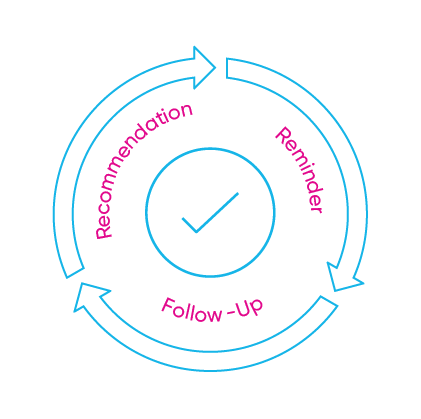How to improve flea, tick, and heartworm prevention compliance
By MWI Animal Health

Successes in modern veterinary medicine create a level of complacency among today's clients. As an example, proactive parasite prevention products work so well that many pet-loving families from younger generations lack real-world experience with rampant flea infestations. Even those who've faced the reality of fleas, ticks, and heartworms and the illnesses they bring may not remember just how bad things get if not kept in check.
Common causes of noncompliance
On top of complacency, people accidentally create compliance gaps because of the exhaustion and distractions of daily life. It's easy to put off making that appointment, calling in a refill, or placing that online order. People also likely think, “Well, another week won't matter. It'll be fine."
Budget stresses — especially among families experiencing long-term job loss during the pandemic — sometimes cause compliance gaps, where pets go for a month or several months without protection purely for financial reasons.
Inadequate reminder systems also contribute to low compliance. If veterinary practices don't reiterate the importance and timing of using key pet-care products, then people often assume they aren't necessary, or they don't understand the risk of taking a haphazard approach to parasite protection.
Issues with product literacy also crop up. These mischaracterizations and misunderstandings about what various flea, tick, and heartworm products contain or how they work enter conversations among people who share their lives with dogs and cats. These conversations often feature inflammatory words like “poison."
Pet health education for improving compliance
Your practice can address complacency through pet health education in the exam room and through educational marketing, including social media posts, videos, and infographics.
- Remind people how quickly flea infestations take hold (40 to 50 eggs a day), how long it takes to get a home infestation under control (often three months), and how uncomfortable fleas make pets — especially those with known allergy issues
- Explain again the various diseases ticks cause, the medical impact of those illnesses on pets, and the timelines and cost of treatment
- Share the latest heartworm disease incidence data for your local area to reiterate the risk and be specific when explaining the timeline, costs, and challenges of heartworm treatments
- Continually promote options for never running out of flea, tick, or heartworm preventive products such as long-acting injectables, auto refill, and bulk order
- Include parasite preventive products in budget friendly, annual wellness plans, which spread costs out through automated, affordable monthly payments
However, consider tackling product literacy issues and concerns more directly with individual veterinary clients. In most cases, simply sharing facts won't turn their thinking around. Instead, take a curiosity approach to conversations to find the real reasons, feelings, and values behind concerns about using these preventive products.
Avoid starting questions with the word why. Instead ask about their worries and feelings of being overwhelmed. Look for places people get stuck and brainstorm more doable solutions to those sticking points.
Use education and genuine curiosity to move some clients from occasional use of preventives to year-round compliance for better pet health. Be open to their replies so that people feel heard, rather than dismissed. Then, pivot to make a specific pet health recommendation such as this:
“Thank you for sharing your concerns and feelings. I appreciate having these conversations so that we better understand each other. I recommend that you use flea, tick, and heartworm preventives all year for [insert pet's name]. Is that realistic and doable for you right now?"



Systemic strategies for improving preventive compliance
Consider systemic compliance strategies like these:
- Establish goals for increasing exam room recommendations by practitioners, then track progress toward the goal with data sorted by provider
- Set up multi-layered reminder timelines and processes that include postcards, emails, text messages, and phone calls before patients fall into noncompliance and afterwards, as needed
- Use flags in veterinary practice software so that any team member knows what is due soon and what is out of compliance and can remind clients in real time
- Preview likely appointment day recommendations at check-in or during history-taking so that people know what practitioners want to discuss
- Make repeating recommendations standard at checkout
- Praise clients for providing such good pet health care by using parasite preventives
If you don't know how to set these things up in your current systems, ask your representatives from software and technology providers for one-on-one help. Look for a technology solution that includes appointment calendar notification of pet non-compliance, automated reminder emails, and text messaging options that will help support your compliance goals.
The value of prevention
It's important for veterinary clients to understand the risk and ramifications of not protecting pets from fleas, ticks, and heartworms and the diseases they cause. Veterinary practice teams can present the value of prevention in three core messages:
- Prevention saves families time, worry, and money and saves pets from unnecessary suffering
- By avoiding preventable problems, families free up the time and energy to improve pet health and enrich pets' lives in other ways
- Because veterinary teams aren't overrun with cases from preventable problems, they have the time and energy to handle urgent cases as well as other important veterinary needs such as orthopedic issues, cancers, and metabolic diseases
For patients the value of prevention compliance comes from avoiding the suffering and physical strain of the parasites themselves as well as the diseases they cause. All that stress on the body affects their emotional health and potentially makes them more susceptible to other illnesses and problems.
The power of client empowerment
Client empowerment comes from consistent access to information, expert guidance and recommendations, and positive reinforcement of their efforts. People want to feel smart and capable when it comes to raising pets. Help set clients up for a lifetime of success:
- Teach clients how to be better partners in their pet's health care
- Make specific recommendations for each individual pet at every contact point
- Provide guidance and support for using preventive products, including making getting refills fast and easy and coaching them through any challenges
- Thank them for their pet health partnership and tell them what a great job they're doing, every step of the way
Improving client compliance with preventive health measures, including flea, tick, and heartworm products, takes a multi-pronged approach. When veterinary practices understand when and why noncompliance happens and target their client education efforts toward those challenges, they build a strong foundation for better compliance across the board.
In addition, veterinary practices need to leverage solutions and technologies to make compliance efforts easier and more automated. These steps help clients comprehend and value preventive care and help empower them to be capable, active, and enthusiastic partners in pet health.
Improve compliance, retention and growth
Leverage client communications software and digital marketing campaigns





